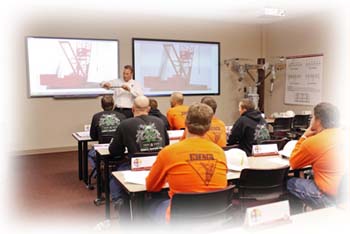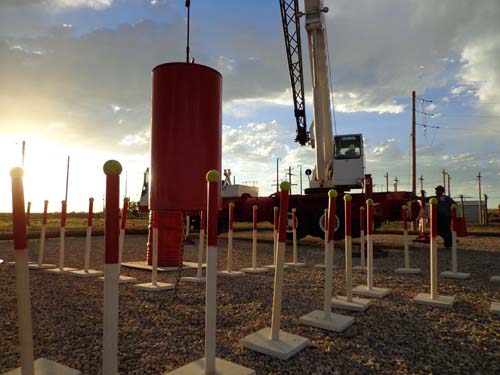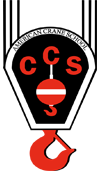Crane Training
Pricing | Training Schedule
California Crane School guarantees that anyone who takes our class, read the English language, and demonstrate basic arithmetic skills (adding & subtracting) will pass the crane operator certification Written Exams or their next open enrollment class with us is FREE (up to one year from original training session).
Currently California Crane School teaches a 16-hour telescopic boom crane class that covers both fixed and swing cab telescopic boom cranes. We try to keep the lattice boom cranes separate so that class time is spent on the specific material pertaining to the cranes that most crane operators in California and Nevada will be operating.
California Crane School understands that not every student who attends this class is a full-time crane operator. Many students have other professions such as being plumbers, mechanics, linemen, and maintenance workers that only operate a crane from time to time. We have designed an intense, fun course complete with practical (hands on) testing that will get anyone from beginner to expert through the crane operator certification Written Exams with ease in just two days. We have the reputation and the pass rates to prove it.
Items covered in the class:
OUR CLASSES COVER EVERYTHING YOU WILL NEED TO KNOW TO PASS THE CRANE OPERATOR CERTIFICATION WRITTEN TESTS.
|
 |
Crane Class Times:
Day One 8:00am - 4:30pm: Classroom Learning.
Day Two 8:00am - 4:30pm: Classroom Learning.
Day Three 8:00am - 12:00pm: Written Exams.
Scheduling for practice time and Practical Exams with the cranes will begin after class on Day Two, and continue after the Written exams on Day Three. In some instances, it may be possible to begin scheduling time on the cranes at the end of Day One.
Sacramento Training
Crane Class and Written Exam Address
University of Phoenix (Sacramento campus)
2860 Gateway Oaks Drive
Sacramento, CA 95863
Practical Site
Ideal Tractor
4101 West Capitol Ave.
West Sacramento, CA 95691
Los Angeles , CA (La Mirada) Training
Crane Class and Written Exam Address
6 Centerpointe Dr.
La Palma, CA 90623
Practical Site
15919 Phoebe Ave,
La Mirada, CA 90638
Crane Operator Certification Written Testing (Mobile Cranes)
- Crane operator certification core test - 90 questions (90 minutes)
- Small telescopic boom crane test - 26 questions (60 minutes)
- Large telescopic boom crane test - 26 questions (60 minutes)
Crane operator certification written tests are separated into 4 domains
(Approximately 24% of the test)
- Know that the suitability of the supporting surface to handle the expected loads of the operation must be assessed. Elements of concern include but are not limited to: (a) weakness below the surface such as voids, tanks and loose fill; (b) weakness on the surface such as retaining walls, slopes, excavations and depressions.
- Know the proper use of mats, blocking or cribbing and outriggers or crawlers as they affect the suitability of supporting surfaces to handle the expected loads of the operation.
- Know site hazards and restrictions, such as electric power lines and piping.
- Know how to identify and evaluate site access and usability.
- Know how to review planned operations and requirements with site supervision (i.e., signal person), to include determination of working height, boom length, load radius and travel clearance.
- Know how to determine if there is adequate room for extension of crawlers or outriggers/ stabilizers and counterweights.
(Approximately 23% of the test)
- Know which federal regulations and industry standards affect safe operation of the crane, including ASME/ANSI B30.5.
- Know how to inspect the crane tour tin sate conditions, complete required records, and communicate the unsafe conditions to the proper authority.
- Know how to pick, carry, swing and place the load smoothly and safely on rubber tires and on outriggers/stabilizers or crawlers (where applicable).
- Know how to communicate at the site with management, the crew and the signal person.
- Know proper procedures and methods of reeving all wire ropes and methods of reeving multiple-part lines and selecting the proper load block and/or ball.
- Know standard hand signals as specified in ASME/ANSI B30.5.
- Know how to react to changes in conditions that affect the safe operation of the crane.
- Know how to shut down and secure the crane properly when leaving it unattended.
- Know the manufacturer's specifications for operating in various weather conditions, and understand how environmental conditions affect the safe operation of the crane.
- Know how to properly level the crane.
- Know how to verify the weight of the load and rigging prior to initiation of the lift.
- Know how to determine where the load is to be picked up and placed and how to verify the radii.
- Know basic load rigging procedures.
- Know how to perform daily maintenance and inspection.
- Know how to use the following operator aids:
- LMI and rated load indicator
- wind indicator
- anti-two block device
- boom angle indicator
- load indicating device
- boom length indicators
- drum rotation indicators
- Know that the following operations require specific procedures and skill levels:
- multi-crane lifts
- suspended personnel platforms
- clamshell/dragline operations
- pile driving and extracting
- concrete operations
- demolition operations
- barge operations
- magnet operations
- multi-drum operations
- Know the proper procedures for operating safely under the following conditions:
- traveling with suspended loads
- approaching two-blocking
- operating near electric power lines
- using suspended personnel platform
- using other than full outrigger/crawler extensions
- lifting loads from beneath the surface of the water
- using various approved counterweight configurations
- handling loads out of the operator's vision ("operating in the blind")
- using electronic communications techniques, such as radios
- Know the proper procedures for load control and the use of hand-held tag lines.
- Know emergency response procedure for:
- fire control
- electric power line contact
- loss of stability
- control malfunction
- two-blocking
- overload
- carrier or travel malfunction
- Know how to properly use the outriggers in accordance with manufacturer's specifications.
(Approximately 28% of the test)
- Know the functions and limitations of the crane and attachments.
- Know wire rope:
- construction and breaking strength
- inspection procedures
- replacement criteria and procedures
- capacity and when multi-part rope is needed
- maintenance
- relationship between line pull and safe working load.
- Know bow to determine the manufacturer's recommended rope for the crane.
- Know rigging devices and their use, such as:
- slings
- spreaders
- lifting beams
- wire rope fittings, such as clips, shackles and wedge sockets
- saddles (softeners)
- clamps (beams)
- Know the limitations of protective measures against electrical hazards:
- grounding
- proximity warning devices
- insulated Jinks
- boom cages
- proximity to electric power lines, radio and microwave structures
- Know the effects of load share and load transfer in multi-crane lifts.
- Know basic crane terms.
- Know the basics of machine power flow systems.
- mechanical
- electrical
- pneumatic
- hydraulic
- combination
- Know the significance of the instruments and gauge readings.
- Know the requirements of pre-operation and inspection and maintenance.
- Know how to use operational assist devices which include:
- anti-two lock devices
- load moment indicators and rated load indicators
- outrigger position indicators
- mechanical levels
- boom angle indicators
- load indicating devices
- boom stops and boom hoist disconnects
- radius indicators
- drum rotation indicators
- boom length indicators
- Know how to calculate net capacity for every possible configuration of crane using the manufacturer's load chart.
- Know how to use manufacturer approved attachments and their effect on the crane.
- Know how to obtain dimensions, weight and center of gravity of the load.
- Know the effects of dynamic loading from:
- wind
- stopping and starting
- impact loading
- moving with the load
- Know the difference between duty-cycle and lifting operations.
- Know the effect of side loading.
- Know the principles of backward stability.
- Know the effects of thermal expansion and contraction in hydraulic cylinders.
(Approximately 25% of the test)
- Know the terminology necessary to use load charts.
- Know how to ensure that the load chart is the appropriate chart for the machine in its particular application.
- Know how to use load charts. This includes knowing:
- the operational limitations of load charts and footnotes
- how to relate the chart to the configuration of the crane, crawlers, or outriggers extended or retracted, jib erected or offset, and various counterweight configurations
- the difference between structural capacity and capacity limited by stability
- what is included in load chart capacity
- the range diagram and its relationship to the load chart
- the work area chart and its relationship to the load chart
- where to find and how to use the "parts-of line" information
- Know how to use the load chart together with the load indicators and/or load moment devices.
Practical Testing (Mobile Cranes)

Small telescopic or fixed cab practical test covers all telescopic boom cranes that have a fixed operators station.
Large telescopic or swing cab practical test covers all telescopic boom cranes that have an operators station that rotates with the upperworks.
Lattice boom cranes covers crawler and truck mounted cranes.
A crane operator is required to complete the following tasks for each crane type on which they would like to be certified.
Pre task familiarization period (15 minutes)
1: Place overhead ball in stop circle (optimum time 1:30)
2: Follow hand signals (not timed)
3: Place overhead ball in two barrels (optimum time 3:30)
Familiarization with test weight (5 minutes)
4-A: Negotiate zigzag corridor with test weight in forward fashion
(optimum time 3:00 Swing cab) (optimum time 4:00 Fixed cab)
4-B: Negotiate zigzag corridor with test weight in forward fashion
(optimum time 3:00 Swing cab) (optimum time 4:00 Fixed cab)
Most of these tasks will be timed.



